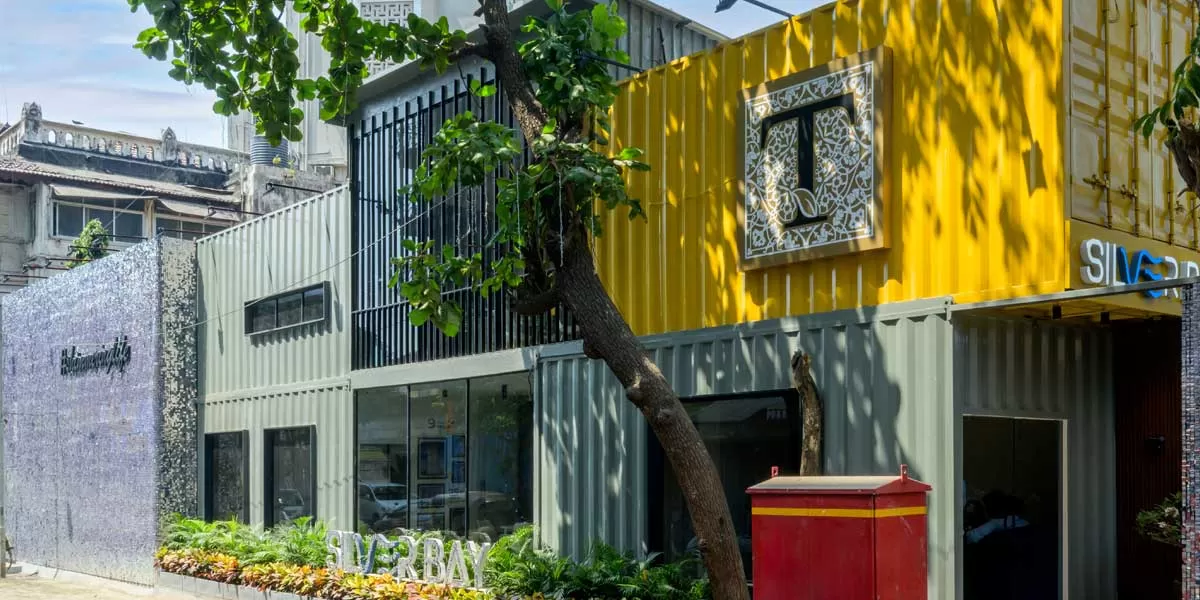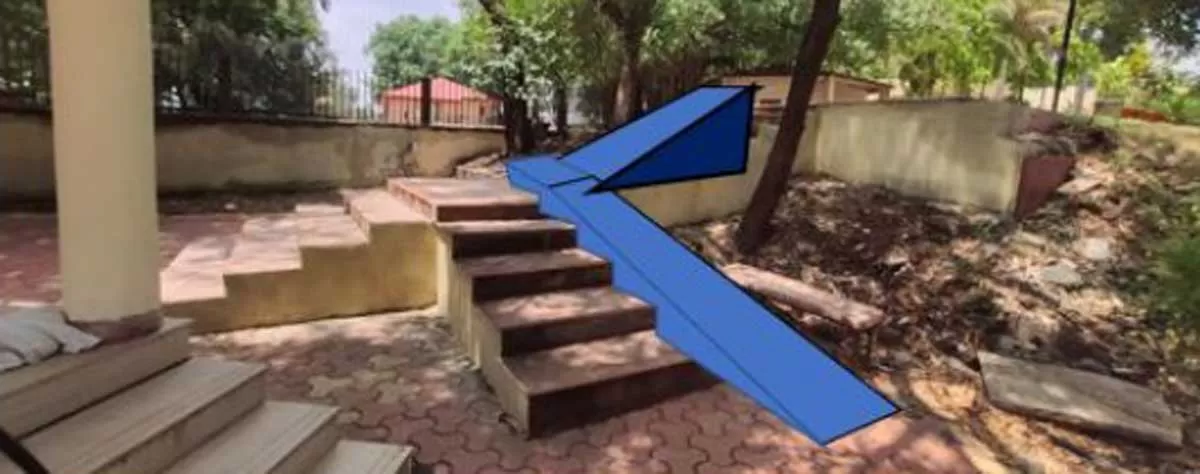A sustainable and cost-effective trend for businesses looking to redefine their work environments is the reuse of discarded shipping containers that are otherwise left to rust in shipyards. Paving the way for new-age temporary structures based on environment-conscious construction principles, SAGI Architects recently opened a prefabricated sales office – using four shipping containers – for Silverbay, an upcoming
luxury residential project by Transcon Developers in
Bandra West, Mumbai.
Founded in 2014, SAGI Architects is a multidisciplinary architecture and interior design practice based in Mumbai, which also undertakes allied works such as HVAC, wiring, etc. Transcon Developers is a leading luxury real-estate builder and developer, offering residential and commercial properties across various locations in Mumbai. The project along with its sales office was officially inaugurated in April 2024 by Shraddha Kedia-Agarwal
and Rishi Todi, Directors,
Transcon Developers.
The client brief
The clients wanted a sales office that would create a positive first impression and make a statement, comprising a double-height reception and waiting area, a virtual reality (VR) room, meeting room, discussion areas and staff area with other ancillary functions – all housed in four shipping containers. The facade with grey and yellow from Transcon’s logo and the shimmering silver effect panels in the tele-callers’ area inspired by the project name (Silverbay) creates a striking visual statement. This approach in creating a high-end sales office for a temporary structure reflects a shared commitment to creativity, luxury, innovative design, efficient space planning and sustainability. Further, the office is based on design principles to minimise heat gain, use natural light and reduce energy consumption.
“The initial brief to our architect was to create a temporary yet striking sales office for Silverbay, integrating the project’s upscale ethos with eco-friendly practices,” says Kedia-Agarwal. “The challenges included balancing aesthetics with sustainability while ensuring the space was functional and efficient. Utilising prefabricated shipping containers not only met but also exceeded these goals. These containers, sourced locally and repurposed with robust insulation and efficient space planning, offered a swift construction solution that minimised environmental impact. The result
is a double-height reception
lobby flooded with natural
light, chic interiors featuring sustainable materials, and a workspace that optimises comfort and energy efficiency.”
As for material details, she shares, “The chic interior layout was meticulously designed to maximise natural light, fostering an open and airy atmosphere. Sustainable materials and finishes were deliberately chosen to enhance both aesthetic appeal and functional efficiency. Glass wool was strategically installed between the container walls, combined with gypsum board and framing to provide effective sound and heat insulation. The gypsum boards were expertly painted to emulate finished walls, contributing to the interior’s ambiance akin to that of
a comfortable, air-conditioned office space.”
“The four containers, [8 ft × 20 ft] have been arranged in G+1 arrangement with two containers making up each floor and were transported to the site by trailers,” says Akash Dudhe, Founder and Principal Architect, SAGI Architects. “Thus, the location had to be such that a trailer could reach there with ease. Any site to which access is limited, especially in constrained environments,
can increase logistic costs
and complexity.”
The advantages
In an era where environmental consciousness is paramount, businesses contribute to the reduction of waste by reusing decommissioned shipping containers. Repurposing containers exercises creativity in designing a unique space and also minimises the environmental impact by reducing landfill waste and the need for virgin materials. Additionally, prefabrication allows for swift construction, minimising resource consumption during the temporary build.
“Using containers as an alternative to traditional construction materials can save
20 per cent in embodied energy and 49.3 per cent in CO2 emissions,” points out Dudhe. Finally, after serving its purpose
for about a year, the containers
can be dismantled and reused on future projects, promoting a
circular economy. “The Silverbay sales office is going to be a temporary structure that would stand on the construction site premises for only about a year,” he adds. “Thus, using shipping containers was preferred over a building made in the conventional construction method.”
As time is money and traditional construction projects can take months, if not years, to complete, container offices offer a rapid deployment solution for businesses seeking to set up quickly. They can be modified and installed in a fraction of the time, significantly reducing downtime and associated costs, making them an ideal choice as a cost-effective and efficient workspace solution. “Repurposed shipping containers are often cheaper than constructing traditional temporary structures from scratch or using other modular solutions,” affirms
Dudhe. “As the containers are already manufactured, the cost of materials is generally lower.”
Further, they can be customised as open-plan offices, individual workstations or collaborative spaces to accommodate diverse workstyles. In view of changing locations and rapid expansion, a major standout feature is their inherent mobility – such offices can be seamlessly relocated without extensive construction, ensuring that the workspace evolves along with
the business, adapting to
changing circumstances and
growth prospects.
Designed to withstand the
rigours of maritime transport, shipping containers are inherently durable. Their steel construction, waterproof nature and structural strength provide resistance against the elements, ensuring a weather-tight environment for business operations, translating into a lower maintenance burden over time. “They are made of high-grade wind-tight and watertight steel, are extremely durable and built to withstand the harshest weather conditions and frequent transportation, making them
ideal for reuse,” says Dudhe. “Generally, they can be used for about 15 years; if maintained well, up to 30 years.”
“Preparing the containers offsite, including treatment like painting and any necessary modifications, can save both time and money,” he adds. “Offsite work can be more efficient and controlled, reducing labour costs and potential delays. While the containers are being prepared offsite, onsite work such as creating the plinth can proceed simultaneously. This concurrent workflow can significantly reduce overall construction timeline and associated costs.” What’s more, if the structure is temporary (like the sales office), no specific permits are required to repurpose containers in this manner.
Of course, there are limitations
to their use. “Shipping containers come in standardised sizes that can restrict design options and may not always align perfectly with the needs of the workspace,” acknowledges Dudhe. “Designing an efficient
layout within these constraints requires careful planning to optimise space utilisation.”
Ship-shape industry!
In his view, such workspaces are particularly well-suited for restaurants, coffee shops, working spaces, retail shops and even second homes. “The conversion of containers into workspaces is a feasible option for many applications due to their affordability, durability and adaptability. With careful planning and execution, these challenges can be overcome to create functional and attractive workspaces.”
For instance, shipping
containers have been used in an innovative way in an international project in Southampton Port, UK, saving around 40 per cent against the cost of a traditional building of the same size. Indeed, such
eco-friendly architecture represents a forward-thinking approach to workspace solutions and a sustainable alternative to
traditional construction while catering to the dynamic needs of modern businesses.-R Srinivasan


















